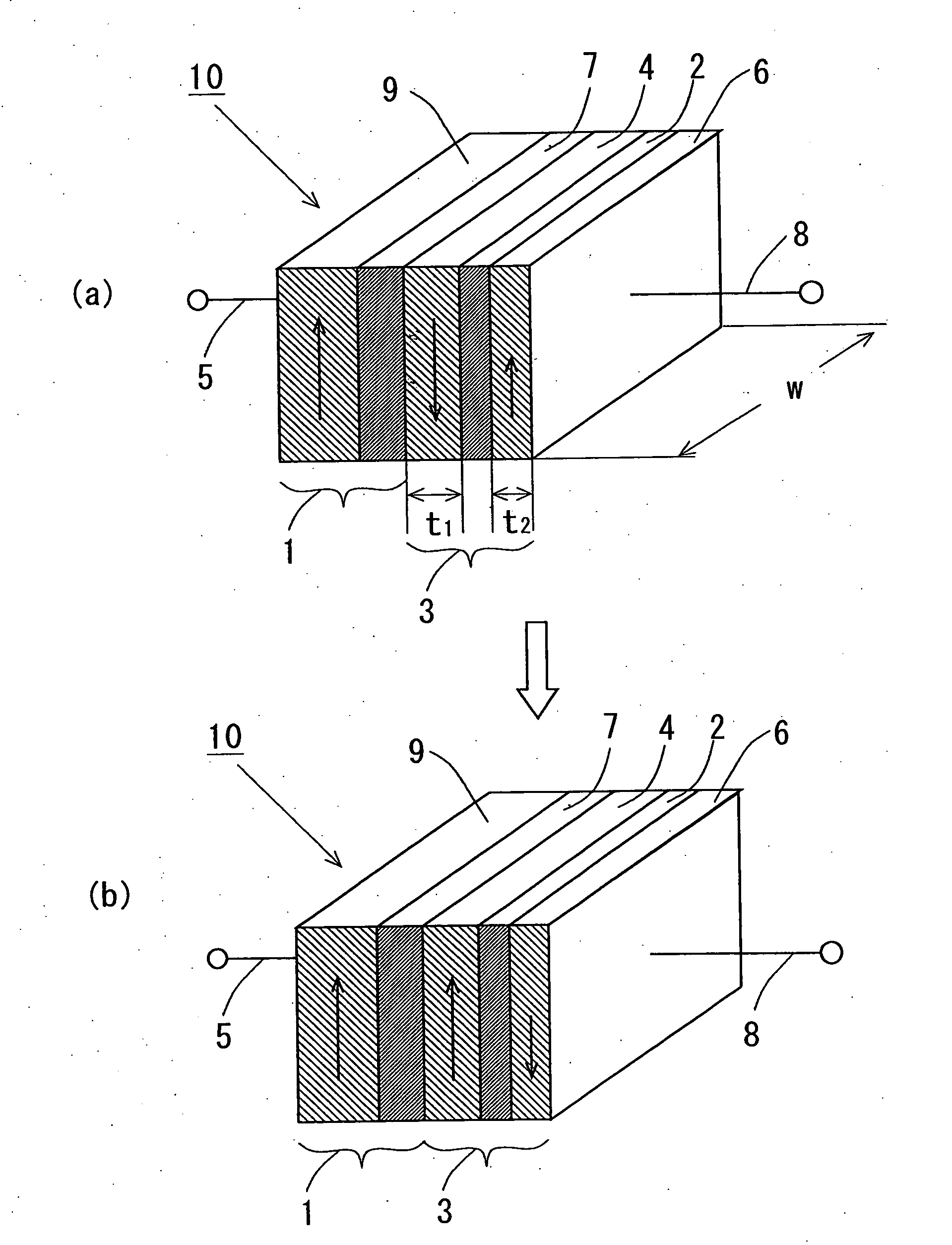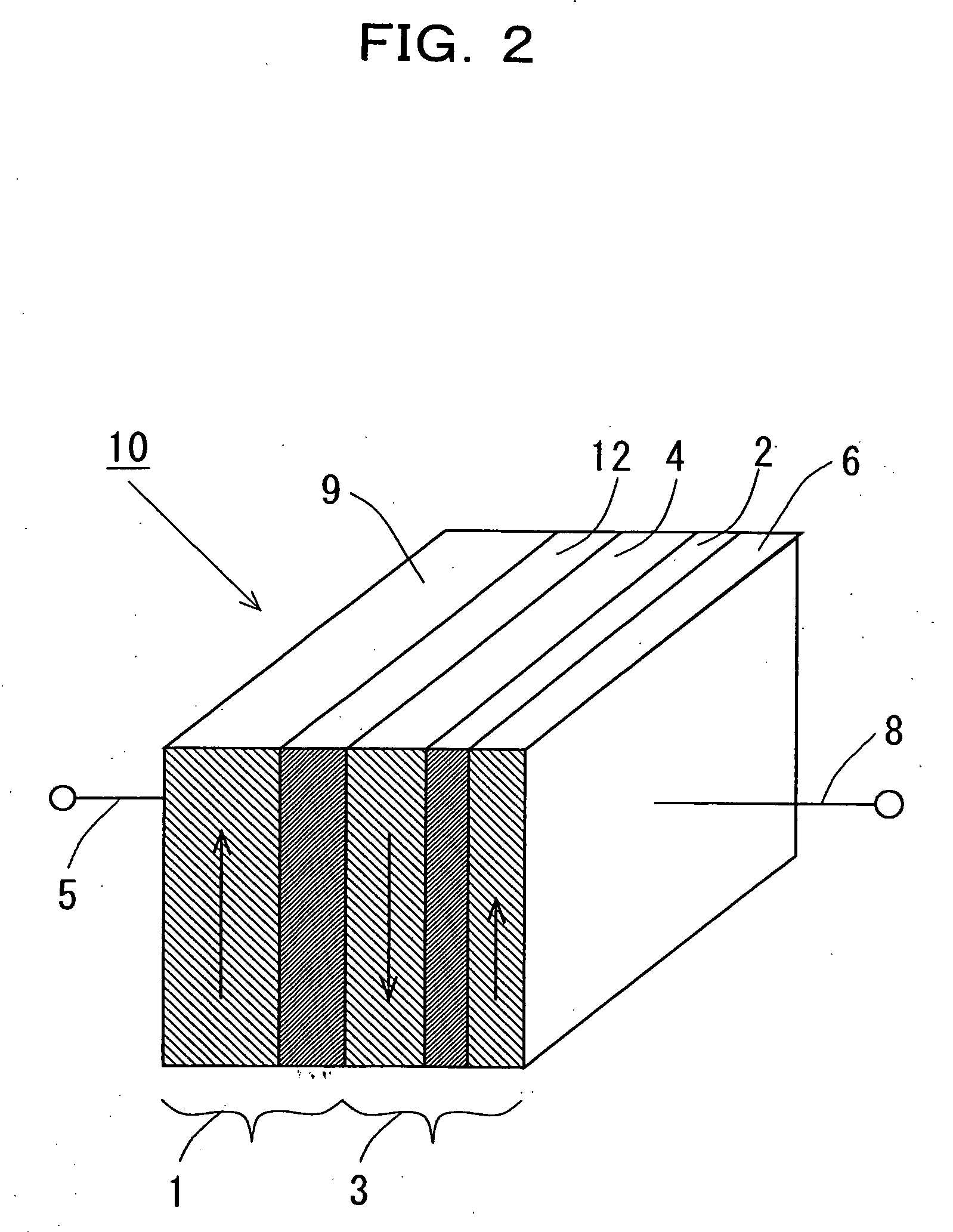Method of using spin injection device
a technology of injection device and spin injection, which is applied in the field of functional devices controlling electronic spin, can solve the problems of increasing power consumption, increasing noise accompanying fluctuation of device quality, and not being practicable to use giant magnetoresistance effect devices of cpp structure, etc., and achieves low external magnetic field, high speed, and high capacity
- Summary
- Abstract
- Description
- Claims
- Application Information
AI Technical Summary
Benefits of technology
Problems solved by technology
Method used
Image
Examples
example 1
[0130]Example 1 is explained next. Example 1 corresponds to the structure of the spin injection device 14 as shown in FIG. 4.
[0131]By using magnetron sputtering method, Ta (2 nm) / Cu (20 nm) / IrMn (10 nm) / Co90Fe10 (5 nm) / Cu (6 nm) / Co90Fe10 (2.5 nm) / Ru (0.45 nm) / Cu (5 nm) / Ta (2 nm) were sputtered in this order onto a thermally oxidized Si substrate. Here, the Ta and Cu layers on the thermally oxidized Si substrate and the top most layers are electrode layers. IrMn and Co90Fe10 layers are a spin polarization part 9 made of an antiferromagnetic layer 21 and a ferromagnetic fixed layer 26, respectively. Cu is an injection junction part 7. Co90Fe10 as Co alloy and Ru are a ferromagnetic free layer 27 and a nonmagnetic layer 28 provided onto Cu of a nonmagnetic layer 7.
[0132]Next, this film was microprocessed using the electron beam lithography and Ar ion milling, to fabricate a spin injection device 14 shown in FIG. 4. The device size was 300×100 nm2.
[0133]FIG. 18 shows the spin injection ...
example 2
[0135]Example 2 is explained next. Example 2 corresponds to the structure of the spin injection device 16 as shown in FIG. 6. By using magnetron sputtering method, Ta (2 nm) / Cu (20 nm) / IrMn (10 nm) / Co90Fe10 (5 nm) / Cu (6 nm) / Co90Fe10 (2.5 nm) / Ru (6 nm) / Co90Fe10 (5 nm) / Cu (5 nm) / Ta (2 nm) were sputtered in this order on a thermally oxidized Si substrate. Here, the Ta and Cu layers on the thermally oxidized Si substrate and on the top most layer is the electrode layer. IrMn and Co90Fe10 layers are the spin polarization part 9 made of the antiferromagnetic layer 21 and the ferromagnetic fixed layer 26, respectively. Cu is the injection junction part 7. Co90Fe10 as Co alloy, Ru, and Co90Fe10 are the ferromagnetic free layer 27, the nonmagnetic layer 28, and a ferromagnetic layer 29 provided onto Cu of the nonmagnetic layer 7, respectively.
[0136]The difference of the spin injection device 16 of Example 2 from that 14 of example 1 is that the film thickness of Ru 28 on Co90Fe10 27 was made...
example 3
[0138]Example 3 is explained next. Example 3 corresponds to the structure shown in FIG. 8. By using magnetron sputtering method, Cu (100 nm) / NiFe (3 nm) / IrMn (10 nm) / Co90Fe10 (3 nm) was fabricated first on a thermally oxidized Si substrate, and then the 3 nm thick SiO2 was sputtered on said film, and further Co90Fe10 (1 nm) / Ru (0.45 nm) / Co90Fe10 (1.5 nm) / SiO2 (3 nm) were sputtered. Next, as the upper magnetic layer, Co90Fe10 (10 nm) / IrMn (10 nm) / Ta (5 nm) film was deposited.
[0139]As the result of transmission electron microscope observation of the cross section of said film, Co90Fe10 (1 nm) / Ru (0.45 nm) / Co90Fe10 (1.5 nm) was particulate merged layer as only one layer in SiO2, and it was seen to be a double tunnel structure with SiO2 as insulating matrix. In said structure, the electric current flew by applying voltage between Cu and Ta films. And the resistance at that time was observed at room temperature with current varied, then as the result, the jump of resistance was observed ...
PUM
| Property | Measurement | Unit |
|---|---|---|
| flowing electric current | aaaaa | aaaaa |
| thickness | aaaaa | aaaaa |
| thickness | aaaaa | aaaaa |
Abstract
Description
Claims
Application Information
 Login to View More
Login to View More - R&D
- Intellectual Property
- Life Sciences
- Materials
- Tech Scout
- Unparalleled Data Quality
- Higher Quality Content
- 60% Fewer Hallucinations
Browse by: Latest US Patents, China's latest patents, Technical Efficacy Thesaurus, Application Domain, Technology Topic, Popular Technical Reports.
© 2025 PatSnap. All rights reserved.Legal|Privacy policy|Modern Slavery Act Transparency Statement|Sitemap|About US| Contact US: help@patsnap.com



